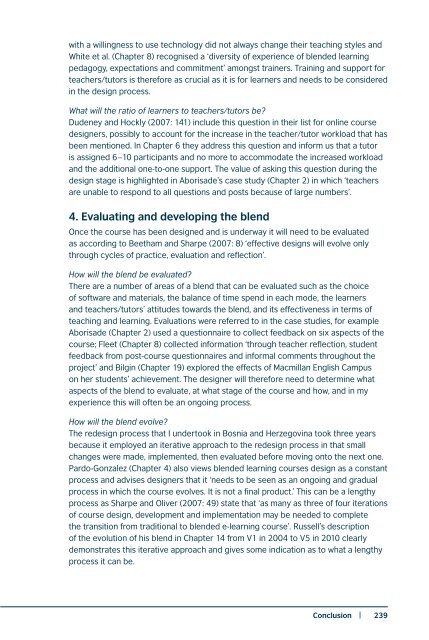Blended Learning in English Language Teaching: Course Design and Implementation
Blended Learning in English Language Teaching: Course Design and Implementation
Blended Learning in English Language Teaching: Course Design and Implementation
You also want an ePaper? Increase the reach of your titles
YUMPU automatically turns print PDFs into web optimized ePapers that Google loves.
with a will<strong>in</strong>gness to use technology did not always change their teach<strong>in</strong>g styles <strong>and</strong><br />
White et al. (Chapter 8) recognised a ‘diversity of experience of blended learn<strong>in</strong>g<br />
pedagogy, expectations <strong>and</strong> commitment’ amongst tra<strong>in</strong>ers. Tra<strong>in</strong><strong>in</strong>g <strong>and</strong> support for<br />
teachers/tutors is therefore as crucial as it is for learners <strong>and</strong> needs to be considered<br />
<strong>in</strong> the design process.<br />
What will the ratio of learners to teachers/tutors be?<br />
Dudeney <strong>and</strong> Hockly (2007: 141) <strong>in</strong>clude this question <strong>in</strong> their list for onl<strong>in</strong>e course<br />
designers, possibly to account for the <strong>in</strong>crease <strong>in</strong> the teacher/tutor workload that has<br />
been mentioned. In Chapter 6 they address this question <strong>and</strong> <strong>in</strong>form us that a tutor<br />
is assigned 6 –10 participants <strong>and</strong> no more to accommodate the <strong>in</strong>creased workload<br />
<strong>and</strong> the additional one-to-one support. The value of ask<strong>in</strong>g this question dur<strong>in</strong>g the<br />
design stage is highlighted <strong>in</strong> Aborisade’s case study (Chapter 2) <strong>in</strong> which ‘teachers<br />
are unable to respond to all questions <strong>and</strong> posts because of large numbers’.<br />
4. Evaluat<strong>in</strong>g <strong>and</strong> develop<strong>in</strong>g the blend<br />
Once the course has been designed <strong>and</strong> is underway it will need to be evaluated<br />
as accord<strong>in</strong>g to Beetham <strong>and</strong> Sharpe (2007: 8) ‘effective designs will evolve only<br />
through cycles of practice, evaluation <strong>and</strong> reflection’.<br />
How will the blend be evaluated?<br />
There are a number of areas of a blend that can be evaluated such as the choice<br />
of software <strong>and</strong> materials, the balance of time spend <strong>in</strong> each mode, the learners<br />
<strong>and</strong> teachers/tutors’ attitudes towards the blend, <strong>and</strong> its effectiveness <strong>in</strong> terms of<br />
teach<strong>in</strong>g <strong>and</strong> learn<strong>in</strong>g. Evaluations were referred to <strong>in</strong> the case studies, for example<br />
Aborisade (Chapter 2) used a questionnaire to collect feedback on six aspects of the<br />
course; Fleet (Chapter 8) collected <strong>in</strong>formation ‘through teacher reflection, student<br />
feedback from post-course questionnaires <strong>and</strong> <strong>in</strong>formal comments throughout the<br />
project’ <strong>and</strong> Bilg<strong>in</strong> (Chapter 19) explored the effects of Macmillan <strong>English</strong> Campus<br />
on her students’ achievement. The designer will therefore need to determ<strong>in</strong>e what<br />
aspects of the blend to evaluate, at what stage of the course <strong>and</strong> how, <strong>and</strong> <strong>in</strong> my<br />
experience this will often be an ongo<strong>in</strong>g process.<br />
How will the blend evolve?<br />
The redesign process that I undertook <strong>in</strong> Bosnia <strong>and</strong> Herzegov<strong>in</strong>a took three years<br />
because it employed an iterative approach to the redesign process <strong>in</strong> that small<br />
changes were made, implemented, then evaluated before mov<strong>in</strong>g onto the next one.<br />
Pardo-Gonzalez (Chapter 4) also views blended learn<strong>in</strong>g courses design as a constant<br />
process <strong>and</strong> advises designers that it ‘needs to be seen as an ongo<strong>in</strong>g <strong>and</strong> gradual<br />
process <strong>in</strong> which the course evolves. It is not a f<strong>in</strong>al product.’ This can be a lengthy<br />
process as Sharpe <strong>and</strong> Oliver (2007: 49) state that ‘as many as three of four iterations<br />
of course design, development <strong>and</strong> implementation may be needed to complete<br />
the transition from traditional to blended e-learn<strong>in</strong>g course’. Russell’s description<br />
of the evolution of his blend <strong>in</strong> Chapter 14 from V1 <strong>in</strong> 2004 to V5 <strong>in</strong> 2010 clearly<br />
demonstrates this iterative approach <strong>and</strong> gives some <strong>in</strong>dication as to what a lengthy<br />
process it can be.<br />
Conclusion | 239


